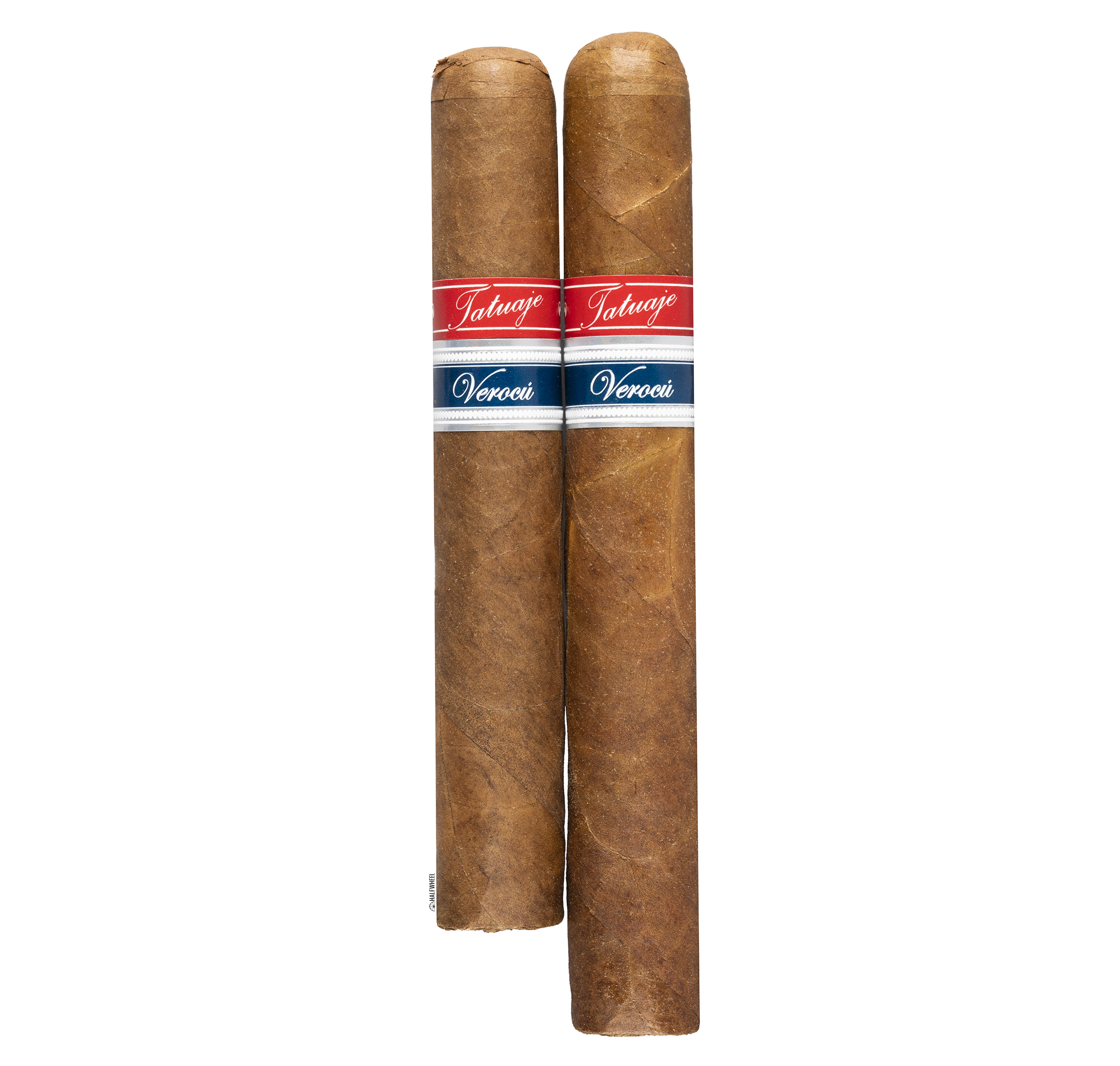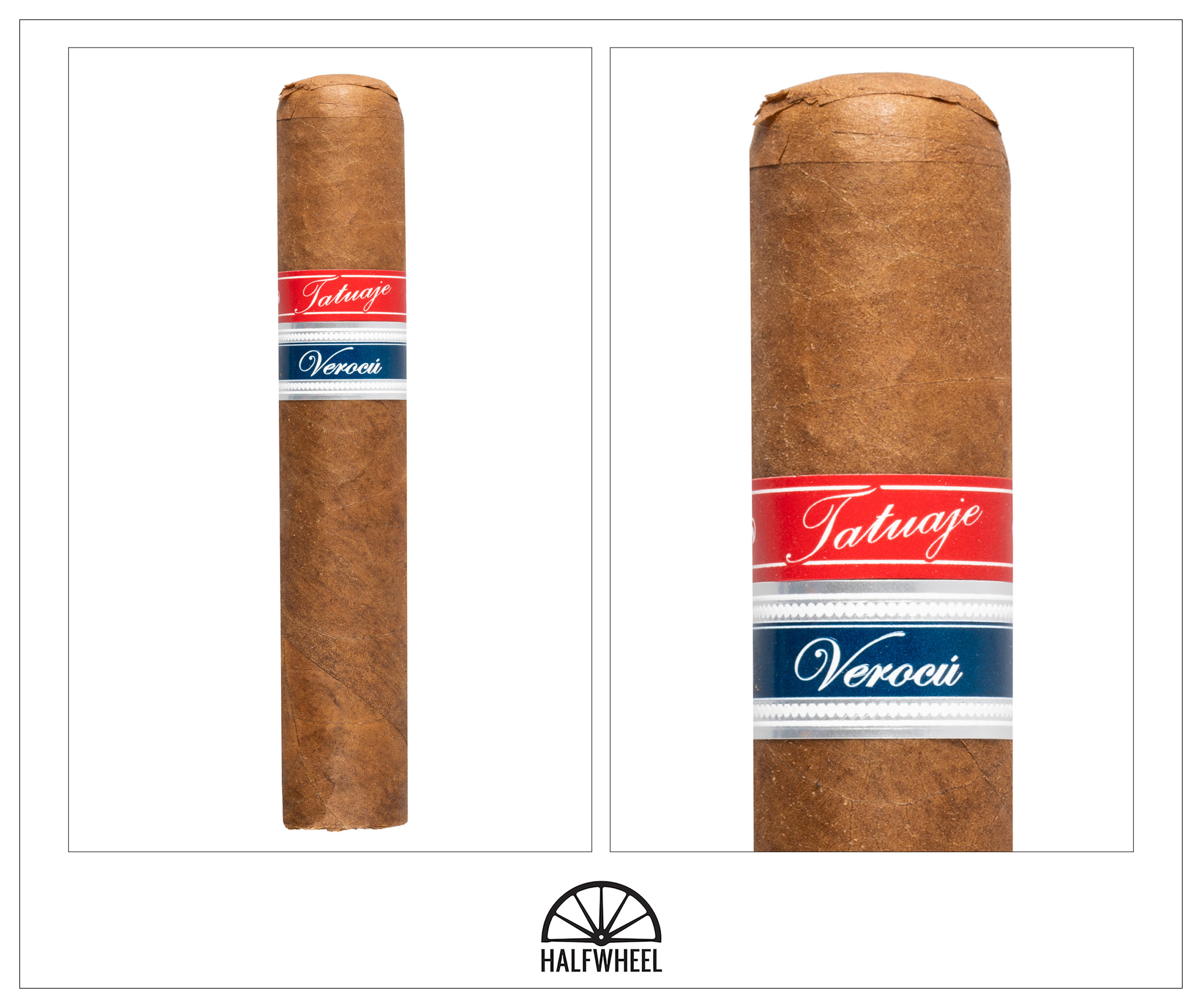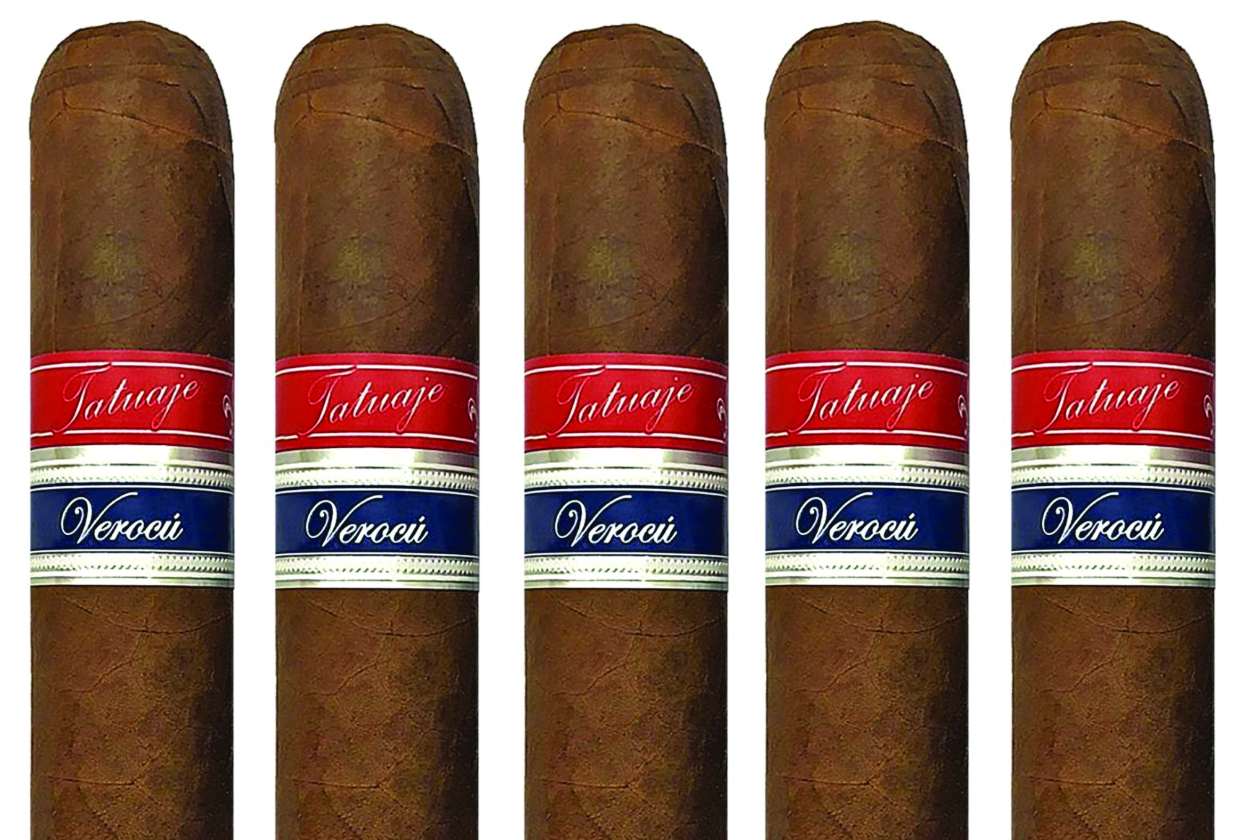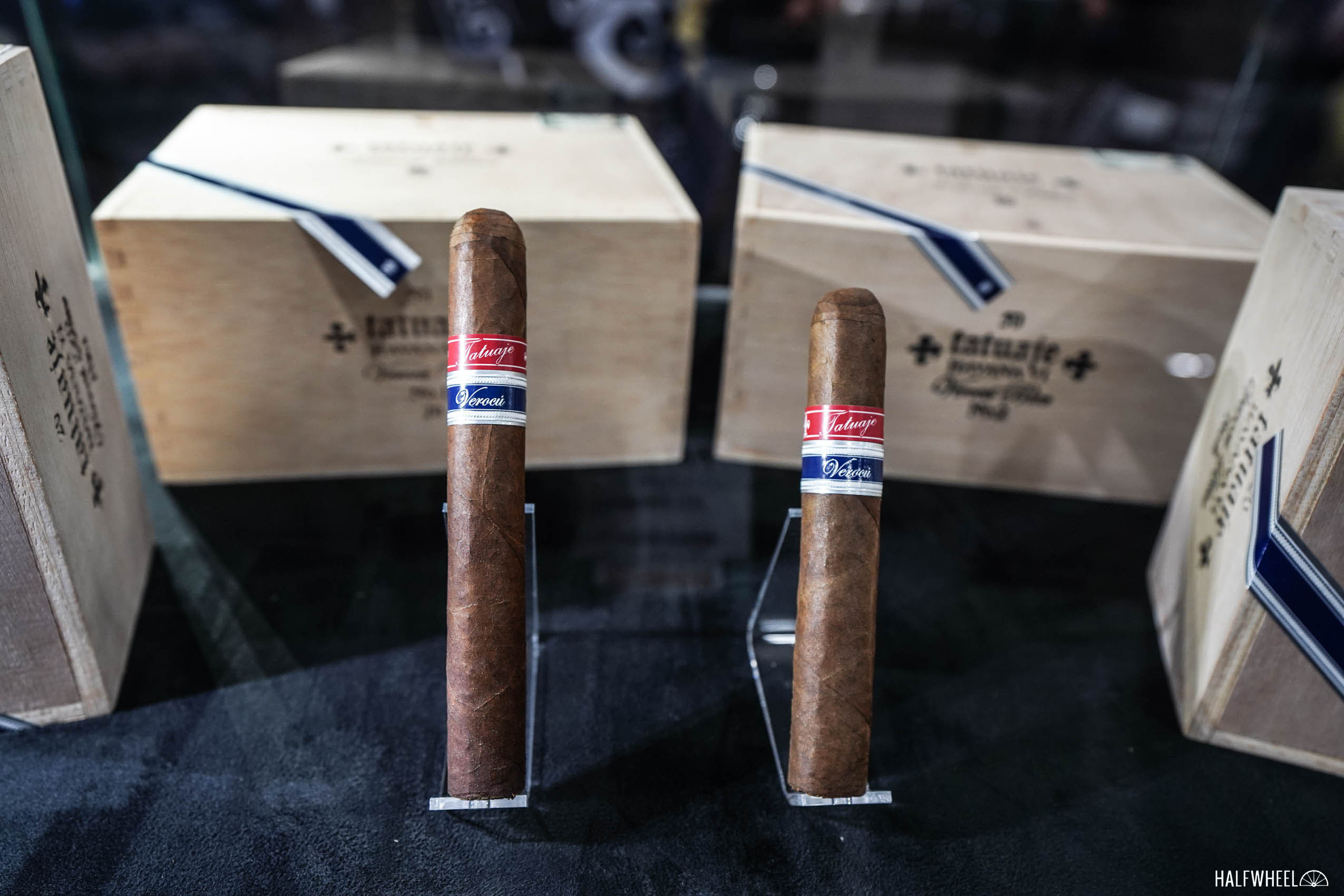If you’ve been following Tatuaje’s new releases in recent years, you’ve undoubtedly noticed that Pete Johnson has been digging in the vaults and bringing back some high-profile cigars, such as the T110, and then adding new variations on the wrapper, using either a Connecticut broadleaf, Ecuadorian Sumatra or Ecuadorian habano wrapper. That trio could easily be referred to as Tatuaje’s main options for wrappers, and for a while, it seemed like those kinds of releases might make up the majority of new products for Tatuaje.
It was this seeming pattern that Tatuaje got into that had me quite intrigued by one of the company’s new releases at the 2022 PCA Convention & Trade Show, the Tatuaje Havana VI Verocú Blue.
The cigar started appearing on social media in early June, and was notable for the addition of a secondary band with a blue, silver and white color scheme, which when combined with the Havana VI line’s red primary band, gave the cigar a distinctively patriotic feel, especially in light of the upcoming July 4th holiday.
The lineage of this cigar dates back to the mid-2000s and the Havana VI line, one of the first lines to be made by Tatuaje and which uses an Ecuadorian wrapper over a Nicaraguan double binder and filler. It is also notable for being the follow-up to the company’s original Miami-made brown label cigars, though to help lower the cost, the cigar was—and still is—made in Nicaragua.
In 2007, Johnson released the Tatuaje Verocú, a pair of cigars that were released regionally. The Lado Occidental was a 6 1/4 x 52 vitola that was released to retailers in the western half of the United States, while the Zona del Este measured 5 1/2 x 54 and went to retailers in the eastern half of the country.
While originally released as a limited, regional edition, the Havana VI Verocú would go on to become a regular production line, adding several other sizes, all with numerical names. Talking about the Verocú line at the 2015 IPCPR Convention & Trade Show, Johnson described the cigar as “a baby Cojonú or a red label on steroids,” with a blend that used an Ecuadorian habano wrapper over a Nicaraguan double binder and filler.
Fast forward to 2022, and there is a new extension to the Tatuaje Havana VI Verocú line.
The Tatuaje Havana VI Verocú Blue was originally intended to use an Ecuadorian habano claro wrapper, but Johnson eventually settled on a Nicaraguan corojo 99 rosado wrapper during the blending process, which he said spanned four years. This isn’t the first time that Johnson has used this particular wrapper, as it has been used on cigars in the Tatuaje Escasos Collection, a limited production, Miami-made series of cigars that gets its name from the Spanish word for scarce. In 2019, Tatuaje made an Escasos variation on the Brown Label, or Selección de Cazador line, initially using an Ecuadorian rosado habano claro wrapper, though that wrapper was changed to the Nicaraguan corojo 99 shade grown wrapper as of April 2020.
Note: The following shows the various Tatuaje Havana VI Verocú Blue vitolas. Some of these cigars may have been released after this post was originally published. The list was last updated on Dec. 8, 2022.

87
Overall Score
If you're a fairly regular smoker of Tatuaje's cigars, particularly the Selección de Cazador, Havana VI and Havana VI Verocú lines, it won't take long to realize that this is a bit of a different profile than you might be used to from Pete Johnson. The first third sets the tone early and while the profile undergoes some changes, it doesn't stray too far from how it started, nor does it turn into anything you might mistake for the aforementioned cigars. That said, I found the Tatuaje Havana VI Verocú Blue No.2 to be a rather enjoyable change of pace from the majority of Tatuajes that I have been smoking lately, especially the first one that I smoked for my own enjoyment, as it immediately caught my attention by way of its lighter profile. This is definitely worth a try, as it would seemingly have a good choice making it into almost any cigar smoker's rotation.
Johnson has said he might release another size or two in the future that would mimic a size in the red label Tatuaje Havana VI Verocú line, though no specifics have been announced yet.

- Cigar Reviewed: Tatuaje Havana VI Verocú Blue No.2
- Country of Origin: Nicaragua
- Factory: My Father Cigars S.A.
- Wrapper: Nicaragua (Corojo 99 Rosado)
- Binder: Nicaragua
- Filler: Nicaragua
- Length: 5 1/2 Inches
- Ring Gauge: 54
- Vitola: Robusto Extra
- MSRP: $12 (Box of 20, $240; Box of 50, $600)
- Release Date: August 2022
- Number of Cigars Released: Regular Production
- Number of Cigars Smoked For Review: 3
As I take the Tatuaje Havana VI Verocú Blue No.2 out of my humidor and its cellophane sleeve, I find myself thinking of what I would consider being the average color of the shades of wrappers that Tatuaje uses on its cigars. The one on this cigar feels a bit lighter than average and it’s interesting to consider that this cigar’s wrapper is considered a rosado shade. The word rosado means pink or rose-colored, though that’s certainly not the word that comes to mind, as I would be inclined to call the wrapper a light and nutty shade of brown. Beyond that, the leaf is on the dry side, with a bit of bumpiness thanks to the veins of the wrapper and seemingly some of the veins of the binder. The cigar has a bit of give to it but is generally firm and appears to be rolled very well. The aroma from the foot is light and contains a bit of creaminess, saturated cornflakes, cashews and a bit of underlying sweetness that reminds me just a bit of marshmallows. Behind all that, there is a bit of dry wood and just a pinch of pepper, which gently tingles my nostrils. The cold draw is smooth and easy, while the flavor is more subdued than the aroma, offering a soft bread flavor and texture, a bit of creaminess and essentially no pepper.
Much like I said the wrapper on the Tatuaje Havana VI Verocú Blue No.2 is lighter than the average Tatuaje release, the first puffs are a bit lighter than what I’d consider the average Tatuaje profile. It’s almost easiest to start by acknowledging that the cigar doesn’t have a lot of earthiness or black pepper out of the game, both fairly notable absences. In their places are dry wood, hints at creaminess, a bit of light toast and light nuttiness, and a more middle-of-the-road pepper that packs a tingle but not a punch of strength. Retrohales have some pepper as well but are fairly mild, serving as an accent to the profile that takes things up a tick or two. Two of the three cigars have profiles that seem almost perfect for a mid-morning cigar with a bit of coffee, while the third cigar’s profile has a bit sharper pepper that I’m not as crazy about as it stands out too far from the rest of the profile. The one plus of that cigar is a bit more of a lingering finish after each retrohale, as I can still feel a tingle several seconds after each passage of the smoke through my nose. While I’m not getting an explicitly creamy flavor at the end of this section, there is something to the texture of the smoke that makes me think of creaminess. Flavor is a bright medium, body is medium-minus and strength is mild. Construction in the first third is very good, particularly the draw and smoke production.

The second third of the Tatuaje Havana VI Verocú Blue No.2 starts with a bit more of a toasty flavor that evolves into a very light wood flavor, almost like kindling or the kind of dried wood you’d find in a woodworker’s scrap pile. Not long after those first puffs of this section, the black pepper begins to evolve and become a stronger component of the profile, giving my taste buds a more pronounced sensation with a bit of robustness and heat. There is a bit of a mismatch between the pepper and the rest of the profile, but things evolve through the midway point helping to bring the overall profile into better congruency. The wood and toast begin to fade into the background, the creaminess becomes more textural than a contributor to the flavor, and a bit of earthiness starts to emerge in their place. If I really pay attention to the cigar, I also pick up a very slight shift that introduces a bit of oiliness into the profile that seems to enhance all of the other flavors. As this section begins to wrap up, the flavor lightens a bit, not to where it was in the first third, but more of a midpoint between the lightest and heaviest parts of the profile thus far. And in a bit of a Goldilocks phenomenon, this midpoint is the best that the cigar has offered thus far. One stubborn section of a wrapper notwithstanding, construction remains very good. Flavor peaks at medium-full but is closer to medium-plus, while body is medium and strength has crept up to medium.

The final third gets underway by trying to swing the flavor back toward the fuller end of the spectrum. That means a bit more earthiness, more black pepper and the occasional bit of a charred note to the wood and toast after those two components reemerge after a brief hiatus. Both the smoke and the flavor at this point have a lot of texture to them as puffs elicit reactions from several points in my mouth, which has both plusses and minuses. It is a good amount of stimulation, though it does elicit what I would describe as some disjointed sensations. One of the three cigars goes off the proverbial tracks with the wood, which intensifies and gets out of balance, but the other two cigars do a much better job staying in balance. The final puffs pick up some heat and intensify the overall profile, but it also offers a very enjoyable fullness in the smoke’s body. Flavor wraps up at medium-plus, body is medium-full and strength is medium. Construction remains very good across the board.

Final Notes
- The cigar that was photographed was the first one I smoked, and as you can see, it had some issues burning the wrapper. Fortunately, it was the only cigar with that issue.
- For those not familiar with cigar terms, it’s easy to see where phases like Nicaraguan corojo 99 rosado wrapper can be confusing. Nicaragua is where it was grown, corojo 99 is the varietal of seed and tobacco, while rosado is one of the color shades that the leaf is capable of, and what was selected for this cigar.
- Conversely, you could have a corojo 99 maduro wrapper, which should be a much darker shade of leaf, as maduro means ripe and generally refers to leaves that are a dark brown. But then you get into the discussion of maduro referring to both a fermentation process and a dark color, which adds another layer to understanding about commonly used terms.
- I didn’t get much if any nicotine strength from the Tatuaje Havana VI Verocú Blue No.2. Each one stayed fairly mild until the very end, and even then it was still shy of the medium mark.
- The cigars for this review were purchased by halfwheel.
- Final smoking time was one hour and 50 minutes on average.
- Site sponsors Atlantic Cigar Co., Corona Cigar Co. and Famous Smoke Shop carry the Tatuaje Havana VI Verocú Blue No.2.
87
Overall Score
If you're a fairly regular smoker of Tatuaje's cigars, particularly the Selección de Cazador, Havana VI and Havana VI Verocú lines, it won't take long to realize that this is a bit of a different profile than you might be used to from Pete Johnson. The first third sets the tone early and while the profile undergoes some changes, it doesn't stray too far from how it started, nor does it turn into anything you might mistake for the aforementioned cigars. That said, I found the Tatuaje Havana VI Verocú Blue No.2 to be a rather enjoyable change of pace from the majority of Tatuajes that I have been smoking lately, especially the first one that I smoked for my own enjoyment, as it immediately caught my attention by way of its lighter profile. This is definitely worth a try, as it would seemingly have a good choice making it into almost any cigar smoker's rotation.
I strive to capture the essence of a cigar and the people behind them in my work – every cigar you light up is the culmination of the work of countless people and often represents generations of struggle and stories. For me, it’s about so much more than the cigar – it’s about the story behind it, the experience of enjoying the work of artisans and the way that a good cigar can bring people together. In addition to my work with halfwheel, I’m the public address announcer for the Colorado Rockies and Arizona Diamondbacks during spring training, as well as for the Salt River Rafters of the Arizona Fall League, the WNBA's Phoenix Mercury and previously the Arizona Rattlers of the Indoor Football League. I also work in a number of roles for Major League Baseball, plus I'm a voice over artist. Prior to joining halfwheel, I covered the Phoenix and national cigar scene for Examiner.com, and was an editor for Cigar Snob magazine.







